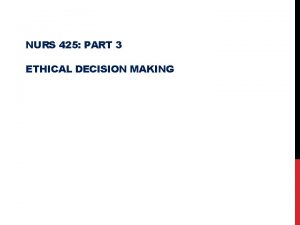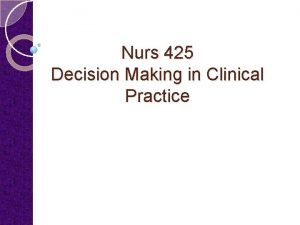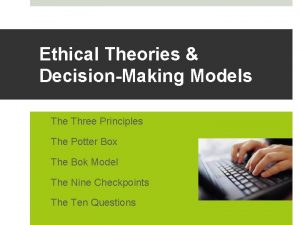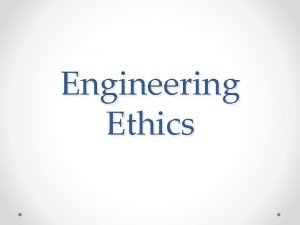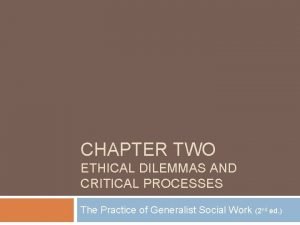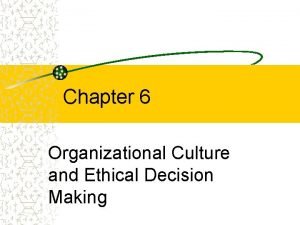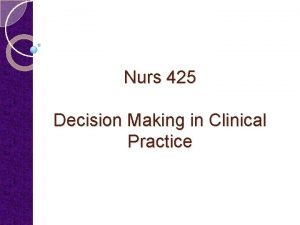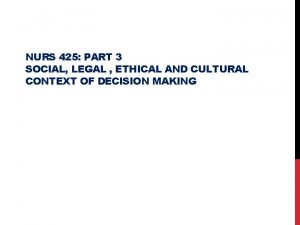NURS 425 PART 3 ETHICAL DECISION MAKING Learning











- Slides: 11

NURS 425: PART 3 ETHICAL DECISION MAKING

Learning objectives: After completing this unit, students are expected to be able to: • • Define ethical dilemma Identify situation when ethical dilemma occurs Define moral distress Understand the processes involved in ethical decision making Define code of ethics Understand the four fundamental responsibilities of nurses Define communication Apply communication skills

Ethical dilemma • Defined as a problem involving a choice between equally desirable or equally unsatisfactory alternatives to the different or competitive assignment of priorities and responsibilities, or to a problem without a satisfactory solution (George & Grypdonck, 2002). (Wolf & Zuzelo, 2006)

Situations when ethical dilemma occurs: • Nurses encountered ethical dilemmas when resources were limited, such as during the nursing shortage. They experienced moral stress in situations in which they had no control and patients lacked autonomy. External factors prevented nurses from doing what was best for patients. Conflict occurred when moral sensitivity and awareness of moral obligations coexisted. (Wolf & Zuzelo, 2006)

Moral distress is defined as “a psychological disequilibrium and negative feeling state experienced when a person makes a moral decision but does not follow through by performing the moral behavior indicated by that decision” (Wilkinson, 1988, p. 16) The phenomenon of moral distress incorporates the • • situation and the moral situation the moral decision about the right action the perceived inability to act, with resultant painful feelings psychological disequilibrium Moral distress brings about coping behaviors, influenced by the frequency of cases nurses encounter, and affects nurses’ wholeness and patient care. (Wolf & Zuzelo, 2006)

purpose of nursing ethics • to inspire questions and examine what would be the ethically right action in health care situations demanding a choice between at least two undesirable alternatives. Ethics deals with the construction of criteria for judging a person’s behavior. Yet, it also deals with the validation of those criteria, that is, their meaning and whether it is appropriate to abide by them. (Toren & Wagner, 2010)

Ethical decision-making model: a tool for the analysis and resolution of dilemmas Steps and criteria that can be used to analyze and resolve any ethical dilemma 1. 2. 3. 4. 5. 6. Define the ethical dilemma; Clarify the personal and professional values, ethical principles and laws involved; Identify the alternatives for action; Choose an action; Initiate discussion about unresolved issues; Generalize the solution to other similar cases. (Toren & Wagner, 2010)

1. Define the ethical dilemma • In order to identify the contradictory values, to recognize the key components of a dilemma situation, the dilemma must be defined. • This definition is sometimes confused with summarizing the story. • Questions need to be raised about the meaning of the situation to all the participants and how the behavior of the nurse and the decision of the manager will affect them. (Toren & Wagner, 2010)

2. Clarify the personal and professional values, ethical principles and laws involved • Personal values are based on what you value as important in the dilemma situation: for example, • ‘keeping a promise’, ‘doing no harm’, ‘maintaining professional integrity’, etc. • Professional values are based on nursing codes of ethics and on the values, principles and responsibilities that are relevant to the dilemma situation. • Country laws and regulations are related to health care systems, patients’ rights etc. (Toren & Wagner, 2010)

3. Identify alternatives for action • All possible actions must be identified. • Looking only for the most conventional or routine action must be avoided. 4. Choose an action • Choose the best option for action from the alternatives identified in the previous stage. 5. Initiate discussion about unresolved issues • Discuss and evaluate the process of the action, including what worked, and what did not work, for determining recommendations and future actions. 6. Generalize the solution to other similar cases • Formulate policy guidelines for similar cases. (Toren & Wagner, 2010)

References Ethics in Community-Oriented Nursing Practice. Chap 6. http: //www. library. armstrong. edu/eres/docs/eres/NURS 40051_MAHAN/500006 dun. Ch 6. pdf
 Nurs 425
Nurs 425 Nurs 425
Nurs 425 Ethical habits
Ethical habits Social work code of ethics
Social work code of ethics Ends based thinking
Ends based thinking Engineering ethics rules
Engineering ethics rules Reamer's ethical decision making model
Reamer's ethical decision making model Organizational culture and ethical decision making
Organizational culture and ethical decision making Understanding how csr differs from conscious marketing
Understanding how csr differs from conscious marketing 7 step ethical decision making model
7 step ethical decision making model Kerridge’s ethical decision-making model
Kerridge’s ethical decision-making model Potter's box for ethical decision making
Potter's box for ethical decision making
